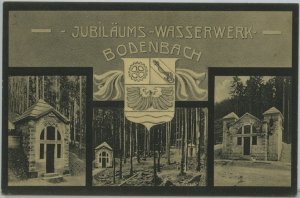
Waterworks

| Popis |
Pastýřská stěna is still important for drinking water in Podmokly. The Podmokel water supply was created in several stages, as the city grew and with it water consumption. The first water supply brought water from the Wolfsbrunn spring near Jalůvčí (Kalmswiese) and was built in 1891 by cedulea pair of architects Adolf Beher and Wilhelm Hübner. In 1909, five springs were located in the Teichgraben Valley at the upper end of the independent village of Bela. Individual springs were collected into underground reservoirs interconnected by mutually through galleries. The reservoir also included two reservoirs, one at the northern foot of the Shepherd's Wall at the edge of the Scrapers per 1000 m3, the other at the top of the Shepherd's Wall with a capacity of 400 m3. All of these waterworks are one architectural unit. They were built of unplastered sandstone blocks, their facade complemented by a city emblem, and each of them in the interior is supplemented by a plaque with the names of the mayor Josef Parthen, city councilors and city engineer Johann Scheinkönig, who contributed to the construction of the water supply. The largest reservoir in the Scraper settlement carries Art Nouveau elements and is decorated with two low turrets on the sides. In 1922, the city joined the system with springs in the Fällergraben valley near Bělá, and after the integration of several surrounding villages in the 1920s, it began to build another water supply from the springs below Popovice Hill (Pfaffenberg). |


